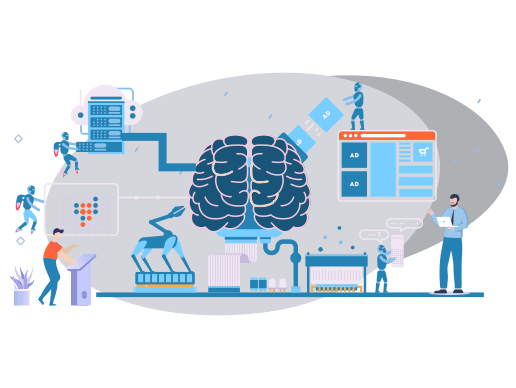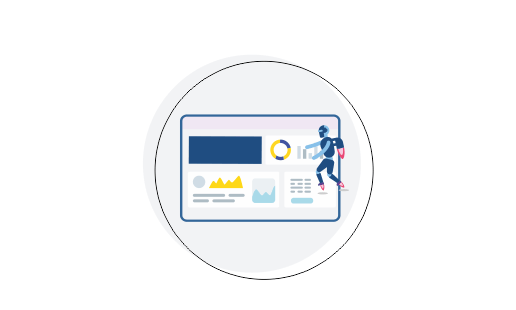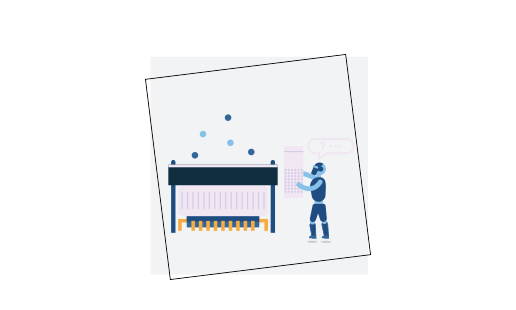

Transform your Products with
AI/Machine Learning
for increased RoI

Machine learning is not just a hot technology trend. It is having a large impact in the digital transformation of businesses.
Machine learning enables digital transformation and increases RoI by greatly improving operational efficiencies and customer experiences in your business. It can analyze much more data than is physically possible, and provide more, faster and better conclusions, which can help digitize and streamline business processes for rapid decision making and execution without human intervention.
Some applications of machine learning include:
If you have implemented big data for your products and services as part of your digital transformation initiative, then you could consider machine learning to accelerate your digital transformation and RoI. Big data can potentially be used to train, test and retrain machine learning models.
While machine learning is promising, there are complexities and challenges that you need to consider:

Not only is machine learning data hungry, it also requires organized and prepared data. It is likely that such good data is not available in your business, and needs to be sourced from industry data, which may be expensive or not easily accessible.

Machine learning is compute intensive and requires significant computing infrastructure for experimentation and testing. This may not be available internally and require significant budgets.

Machine learning is new technology. Skilled resources are in short supply and can be quite expensive to hire.

Machine learning technology is still young and evolving. You need to understand the limits of contemporary machine learning technology, be realistic and allow time for achieving satisfactory results. As the machine learning model learns and executes, it increasingly becomes a black box – it may not be possible for us to understand the rationale behind certain actions.

You need to carefully select the problems you’re looking to automate. Simple processes that are executed frequently and manually with limited outcomes are easier to automate than complicated ones which require careful thought. Also, not all processes that can be automated require machine learning.
Not withstanding these challenges, machine learning is become more accessible with increased computing power of GPUs, CPUs and FPGA processors, enhanced and optimized algorithms and tools to leverage the increased compute power, and the easy, cost-effective availability of cloud-based high performance computing infrastructure. More problems are being solved, and outsourced services providers are bridging the availability of skilled resources in a cost-effective manner.
Do you have an effective machine learning strategy for your products and services?
Connect with us today to transform your offerings with machine learning.
Digital transformation is driving changes in machine learning. Some of the trends in machine learning include:


A wide range of machine leaning tools from leading vendors and open source are now available that let your data scientists focus more on their competences. Tools like MLflow™, Amazon SageMaker® and Azure® Machine Learning Service track different experiment iterations, libraries like Keras, TensorFlow™, Microsoft® Cognitive Toolkit (CNTK) on Azure and Chainer build state of the art models, developer environments like Amazon SageMaker and Azure Machine Learning Studio/WorkBench manage the computing infrastructure, and automated deployment tools like Amazon SageMaker and Azure Machine Learning Ops help in deploying machine learning models.

The availability of new, advanced automated machine learning tools like Google’s Cloud AutoML is expected to fundamentally change machine learning and increase adoption across industries. They could empower your business analysts to evolve machine learning models that can address complex scenarios, without getting lost in processes, workflows and training models.

Once a model is trained and evaluated in a specific tool framework, it is difficult to port the trained model to another framework. To address this challenge, AWS®, Facebook™ and Microsoft® have collaborated to build Open Neural Network Exchange (ONNX) for neural networks Interoperability, which makes it possible to reuse trained neural network models across multiple frameworks.

New, high performance chips and specialized hardware optimized for specific use cases and scenarios will accelerate machine learning. They will speed up the execution of training machine learning models and complex mathematical computations required for computer vision, natural language processing, speech recognition, etc.

With the increase in connected devices, more and more machine learning models trained in the cloud will be optimized and deployed at the edge. Edge machine learning enables inference at the edge, which takes less computing power and can be done in real-time when new data is available, with very low latency and rapid response to local events.

AIOps (or AI-driven IT Operations Analytics) is an approach to IT operations that uses machine learning and predictive analytics to identify anomalies in applications or infrastructure. It helps you improve efficiency by fixing problems before they cause customer issues.
Are you facing challenges in implementing machine learning for your products and services?
Connect with us today to leverage our machine learning expertise.
At Celstream, with nearly two decades of experience in delivering product engineering services for diverse and complex products and apps, we understand what it takes to implement machine learning for the digital transformation of your products and services.
Our product engineering services teams possess extensive expertise in leveraging machine learning tools and technologies from Microsoft, Amazon® and Google™ to transform business processes connected with your products and services:

Celstream is experienced in Amazon SageMaker, a fully managed platform that enables developers and data scientists to build, train and deploy intelligent machine learning solutions, and Azure Machine Learning, Microsoft’s integrated, end-to-end data science and advanced analytics solution, with extensive support for industry standard open-source libraries and toolkits to develop intelligent machine learning solutions.
TRANSFORM YOUR
PRODUCTS AND SERVICES TODAY!